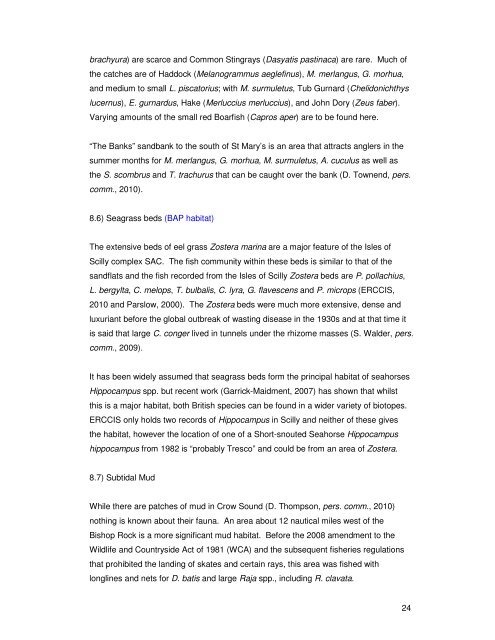Isles of Scilly Fish and Fisheries - Cornwall Wildlife Trust
Isles of Scilly Fish and Fisheries - Cornwall Wildlife Trust
Isles of Scilly Fish and Fisheries - Cornwall Wildlife Trust
Create successful ePaper yourself
Turn your PDF publications into a flip-book with our unique Google optimized e-Paper software.
achyura) are scarce <strong>and</strong> Common Stingrays (Dasyatis pastinaca) are rare. Much <strong>of</strong><br />
the catches are <strong>of</strong> Haddock (Melanogrammus aeglefinus), M. merlangus, G. morhua,<br />
<strong>and</strong> medium to small L. piscatorius; with M. surmuletus, Tub Gurnard (Chelidonichthys<br />
lucernus), E. gurnardus, Hake (Merluccius merluccius), <strong>and</strong> John Dory (Zeus faber).<br />
Varying amounts <strong>of</strong> the small red Boarfish (Capros aper) are to be found here.<br />
“The Banks” s<strong>and</strong>bank to the south <strong>of</strong> St Mary’s is an area that attracts anglers in the<br />
summer months for M. merlangus, G. morhua, M. surmuletus, A. cuculus as well as<br />
the S. scombrus <strong>and</strong> T. trachurus that can be caught over the bank (D. Townend, pers.<br />
comm., 2010).<br />
8.6) Seagrass beds (BAP habitat)<br />
The extensive beds <strong>of</strong> eel grass Zostera marina are a major feature <strong>of</strong> the <strong>Isles</strong> <strong>of</strong><br />
<strong>Scilly</strong> complex SAC. The fish community within these beds is similar to that <strong>of</strong> the<br />
s<strong>and</strong>flats <strong>and</strong> the fish recorded from the <strong>Isles</strong> <strong>of</strong> <strong>Scilly</strong> Zostera beds are P. pollachius,<br />
L. bergylta, C. melops, T. bulbalis, C. lyra, G. flavescens <strong>and</strong> P. microps (ERCCIS,<br />
2010 <strong>and</strong> Parslow, 2000). The Zostera beds were much more extensive, dense <strong>and</strong><br />
luxuriant before the global outbreak <strong>of</strong> wasting disease in the 1930s <strong>and</strong> at that time it<br />
is said that large C. conger lived in tunnels under the rhizome masses (S. Walder, pers.<br />
comm., 2009).<br />
It has been widely assumed that seagrass beds form the principal habitat <strong>of</strong> seahorses<br />
Hippocampus spp. but recent work (Garrick-Maidment, 2007) has shown that whilst<br />
this is a major habitat, both British species can be found in a wider variety <strong>of</strong> biotopes.<br />
ERCCIS only holds two records <strong>of</strong> Hippocampus in <strong>Scilly</strong> <strong>and</strong> neither <strong>of</strong> these gives<br />
the habitat, however the location <strong>of</strong> one <strong>of</strong> a Short-snouted Seahorse Hippocampus<br />
hippocampus from 1982 is “probably Tresco” <strong>and</strong> could be from an area <strong>of</strong> Zostera.<br />
8.7) Subtidal Mud<br />
While there are patches <strong>of</strong> mud in Crow Sound (D. Thompson, pers. comm., 2010)<br />
nothing is known about their fauna. An area about 12 nautical miles west <strong>of</strong> the<br />
Bishop Rock is a more significant mud habitat. Before the 2008 amendment to the<br />
<strong>Wildlife</strong> <strong>and</strong> Countryside Act <strong>of</strong> 1981 (WCA) <strong>and</strong> the subsequent fisheries regulations<br />
that prohibited the l<strong>and</strong>ing <strong>of</strong> skates <strong>and</strong> certain rays, this area was fished with<br />
longlines <strong>and</strong> nets for D. batis <strong>and</strong> large Raja spp., including R. clavata.<br />
24

















